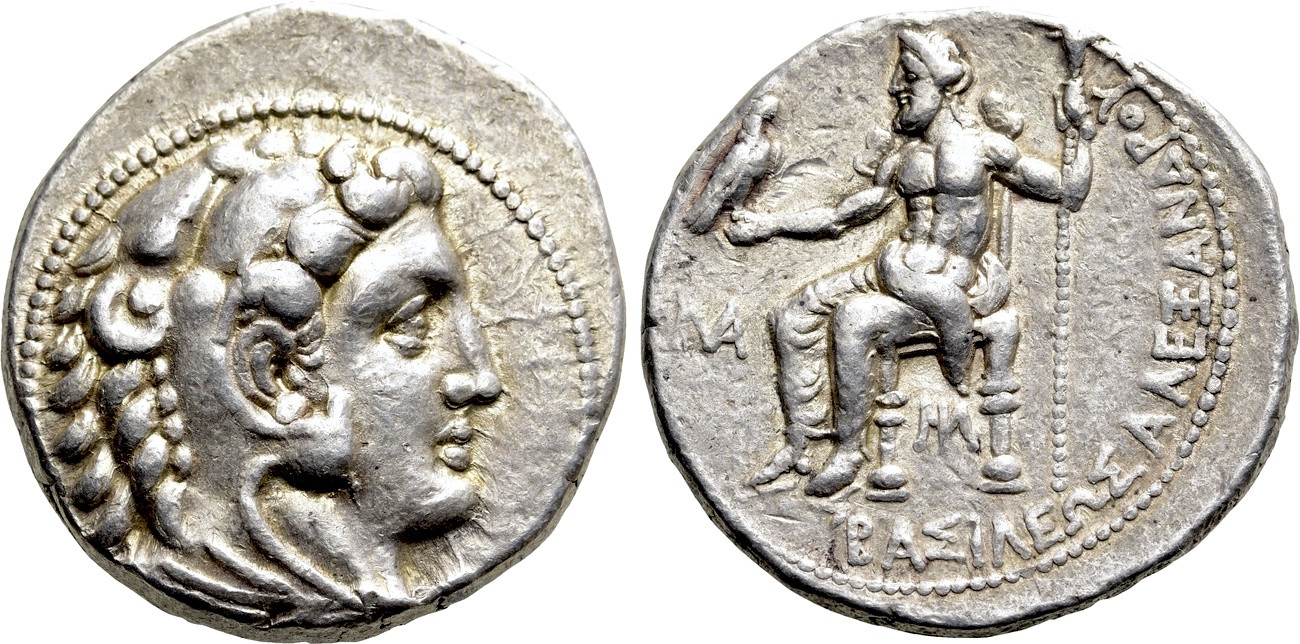Myriandrus? (Alexander the Great), silver, tetradrachms (Heracles/Zeus) (333-319 BCE)
From SILVER
333 BCE - 319 BCE Silver 9,129 kg
Description
| ObverseInscription or printing placed on the obverse.: | Head of Heracles right, wearing Nemean lion skin headdress. Border of dots. |
| ReverseInscription or printing placed on the reverse.: | AΛΕΞΑΝΔΡΟΥ (Greek).ΒAΣIΛEΩΣ AΛEΞANΔPOY. Zeus seated left on throne, holding eagle and sceptre. Controls: Monogram in left field and below throne. |
Mint and issuing power
| MintIdentifies the place of manufacture or issue of a numismatic object.: | Myriandrus | Ancient regionAncient region.: | Cilicia | Modern countryModern country: Turkey | AuthorityIdentifies the issuing power. The authority can be "pretended" when the name or the portrait of X is on the coin but he/she was not the issuing power. It can also be "uncertain" when there is no mention of X on the coin but he/she was the issuing power according to the historical sources: | Alexander III the Great (Argead king, 336-323 BC) |
Chronology
| FromIdentifies the initial date in a range assigned in a numismatic context. | 333 BCE | toIdentifies the final date in a range assigned in a numismatic context.. | 319 BCE | PeriodTime period of the numismatic object.: Hellenistic 323-30 BC |
Physical description
| MetalThe physical material (usually metal) from which an object is made.: | Silver |
Median weightMedian of the weights of numismatic objects (in grams). in grams | 17.00 | DenominationTerm indicating the value of a numismatic object. Examples: tetradrachm, chalkous, denarius.: | tetradrachm |
StandardStandard.: |
Image

H267 Myriandros .jpeg [1]
References
| Die study referencePublication of the study: | Newell 19191Newell 1919, p. 1-42, pl. 1-2. | ||
| Coin series referenceReference to coin series study: | Sear II2Sear II, n° 6713-6725, Price 19913Price 1991, n° 3217-3235, RQEMH4RQEMH, n° 267 | ||
| Coin series web referenceCoin series web references: | |||
Obverse dies distribution
| FrequencyFrequency of specimen in distribution. ᵖ | Number of obversesNumber of obverse dies. ᵖ (o) | % (o) | Number of coinsNumber of coins. (n) | % (n) | Die nameName(s) of the die(s). |
| 1 | 8 | 32 | 8 | 5.23 | 3, 4, 6, 8, 13, 18, 21, 24 |
| 2 | 2 | 8 | 4 | 2.61 | 1, 5 |
| 3 | 2 | 8 | 6 | 3.92 | 2, 23 |
| 5 | 1 | 4 | 5 | 3.27 | 12 |
| 6 | 4 | 16 | 24 | 15.69 | 7, 12, 19, 20 |
| 7 | 1 | 4 | 7 | 4.58 | 14 |
| 9 | 1 | 4 | 9 | 5.88 | 15 |
| 10 | 1 | 4 | 10 | 6.54 | 22 |
| 11 | 1 | 4 | 11 | 7.19 | 25 |
| 13 | 1 | 4 | 13 | 8.5 | 11 |
| 14 | 1 | 4 | 14 | 9.15 | 10 |
| 15 | 1 | 4 | 15 | 9.8 | 16 |
| 27 | 1 | 4 | 27 | 17.65 | 9 |
| Total | 25 of 25 | 100 | 153 of 153 | 100.01 |
Reverse dies distribution
no distribution is available
Quantification
| Number of obversesNumber of obverse dies. ᵖ (o) | 25 | Number of singletons (o1)The number of singleton coins. ᵖ | 8 |
| Number of reverse diesNumber of reverse dies. (r) | 113 | Number of coinsNumber of coins. (n) | 153 |
| Coins per obverse dieNumber of coins per obverse die. (n/o) | 6.12 | Coins per reverse dieNumber of coins per reverse die. (n/r) | 1.35 |
| Reverse per obverse ratioRatio of obverse dies divided by reverse dies. (r/o) | 4.52 | Percentage of singletons (o1)number of coins (n) divided by the number of singletons (o1) ᵖ | 32 % |
| Original number of dies (O) (Carter 1983 formula)The estimation of the number of coins according to Carter 1983 ᵖ | 26.85 | Coins struck if 20,000 as average productivity per dieCoins made if the average productivity for obverses (according to Carter) is 20,000. ᵖ | 537,000 |
| Original number of dies (O) (Esty 2011 formula)The estimation of the number of coins according to the singleton formula in Esty 2011 ᵖ (O) | 29.88 | Survival rate if 20,000 as average productivity per dieSurvival rate if average productivity is 20,000. ᵖ | 0.00028 |
| Coverage (o = % of O) (Esty 1984 formula)Esty 1984 - coverage (% of O) ᵖ (o = % of O) | 94.77% | Die productivity if survival rate 1/2,000Average productivity if survival rate is 1/2,000. ᵖ | 11,396.65 |
| Weight of silver (in kg) if 20,000 coins per die (O = Carter formula)Carter 1983 * Median weight * 20000 (*10 if gold or electrum) ᵖ | 9,129 kg <br /> 9,129 kg | Die productivity if survival rate 1/5,000Average productivity if survival rate is 1/5,000. ᵖ | 28,491.62 |
Remarks
Most likely one single workstation Likely military
References
- ^ Newell, Edward T. (1919), "Myriandros - Alexandria Kat'Isson", AJN 53 (2), p. 1-42, pl. 1-2.
- ^ Sear, David R. (1979), Greek coins and their values. Vol. II, Asia and North Africa, London, xlviii, p. 317-762
- ^ Price, Martin Jessop (1991), The Coinage in the Name of Alexander the Great and Philip Arrhidaeus: a British Museum Catalogue, 2 vol., Zürich-London, 637 p., 637 p., clix pl.
- ^ Callataÿ, François de (1997), Recueil quantitatif des émissions monétaires hellénistiques, Numismatique Romaine, Wetteren, X + 341 p.